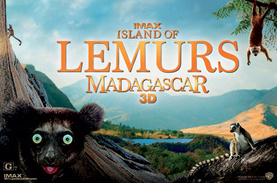
The Ontario Science Centre looked the same when we came in, but there were two registration tables. One was for regular visitors that wanted to watch the film, and one was for all the journalists that came from different media groups. I took a quick peek at the list. Of course, Voice K was on the list. Andrea Mus, the media relations officer at the Science Centre who we also met at the human body exhibition, handed out Lemur T-Shirts. She also gave out posters, little pins and some cute little stuffed lemurs. There were also a stack of kids' activity sheets for other kids that happened to come.
When we first entered the theatre, there was a sloping walkway. If you don't live in a loud and noisy city like Toronto or New York, or don't hear deafening noises daily, you will probably be surprised by the loud sound the movie makes. Normal IMAX theatres are still flat screens, but in an OMNIMAX theatre, the seats are steeply raked. You would look at the ceiling in a relaxed position. Instead of projecting the images onto a flat screen, it is projected onto an entire white dome, and the image almost fills your entire vision. Why is it so big? Each frame of the Imax film’s is ten times bigger than the normal 35mm frame film. The projector is huge, and we mean HUGE.
The movie was exhilarating. The film captured cute dancing lemurs. In one scene, the lemurs were moving so quickly, everyone got dizzy by looking at them. The film also introduced Malagasy and Western scientists who were working on saving the lemurs. We got to hear the haunting song of the Ingri (pronounced IN-jree) that once echoed across Madagascar, but now is fading. We also learned two very interesting facts. One, lemurs arrived as castaways and thrived on the island, and, two, lemurs are the only primates that put females in charge. Even the baby female lemurs have authority over the strong males!
At the end of this lovely 39 minute-long movie, there was a Question and Answer Period with David Douglas, director, and Drew Fellman, producer. There were several raised hands, but one particular question perked up our ears.
“How can we, in Toronto, help the lemurs?”
“Oh, well, go to Madagascar! Be a tourist! Well, because tourism brings in the economy which is very valuable. People will begin to understand that animals have values to the outside world when they’re alive.”.”
After everyone had left, we started our interview. It was quite short.
During the Question and Answer period, Voice K received the opportunity to ask them a question, “Why did you specifically focus your topic on lemurs, while there are thousands of equally as fascinating endangered species out there?”
Mr. Douglas asked, “Like what?”
We replied, “Maybe the … giant panda?”
He then said, “Maybe our next documentary will be on the giant panda!” He and Fellman chuckled.
We also wanted to know if the people in Madagascar would act more and more on saving lemurs.
The reply was, “Yes-more and more. They plan to stop burning down the forests and to make sure the lemurs’ population doesn’t decline.”
We then asked, “Are Doctors Wright and Rasamimanana going to continue their research to help bring the lemurs off the endangered species list?”
Mr. Douglas answered, “Yes, and I think they’re going to work really hard.”
Voice K had a great time at the Ontario Science Centre watching Island of the Lemurs: Madagascar and getting to know a little bit more about David Douglas and Drew Fellman. We hope that you can spare some time to watch Island of the Lemurs: Madagascar in an OMNIMAX theatre to get the full experience.




 RSS Feed
RSS Feed
